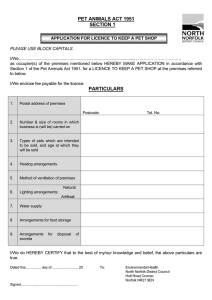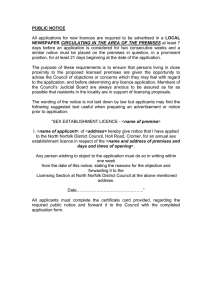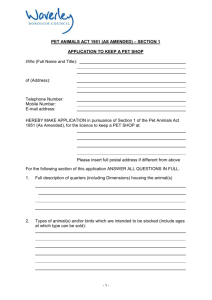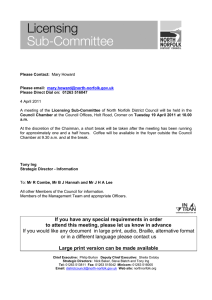PET ANIMALS ACT 1951
advertisement
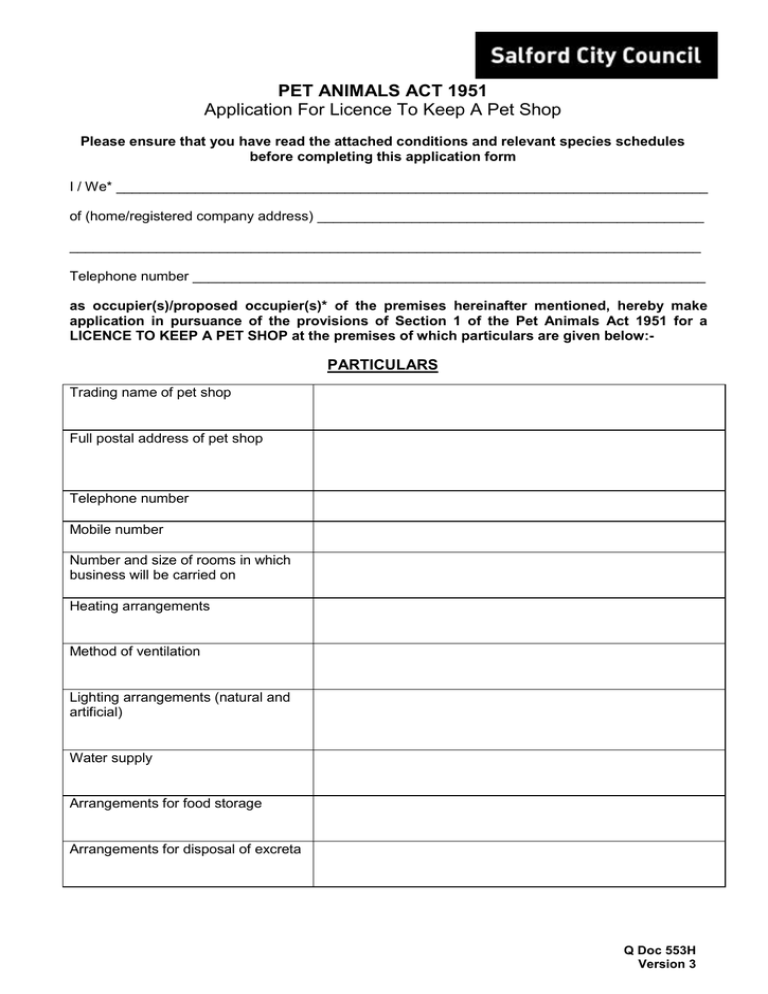
PET ANIMALS ACT 1951 Application For Licence To Keep A Pet Shop Please ensure that you have read the attached conditions and relevant species schedules before completing this application form I / We* ___________________________________________________________________________ of (home/registered company address) _________________________________________________ ________________________________________________________________________________ Telephone number _________________________________________________________________ as occupier(s)/proposed occupier(s)* of the premises hereinafter mentioned, hereby make application in pursuance of the provisions of Section 1 of the Pet Animals Act 1951 for a LICENCE TO KEEP A PET SHOP at the premises of which particulars are given below:- PARTICULARS Trading name of pet shop Full postal address of pet shop Telephone number Mobile number Number and size of rooms in which business will be carried on Heating arrangements Method of ventilation Lighting arrangements (natural and artificial) Water supply Arrangements for food storage Arrangements for disposal of excreta Q Doc 553H Version 3 TYPES OF ANIMALS SOLD (please tick all that apply) The types of animals permitted to be sold will be SPECIFIED on the licence Any animal for sale on the premises that is not specified in the licence will be in breach of the conditions Schedule Animal Please tick all that apply Max number for sale at any one time B C D E Dogs Cats Rabbits Mice Hamsters Gerbils Rats Guinea Pigs Degus Chinchillas Chipmunks F Ferrets G Budgerigar Canary Cockatiel Finches Parakeets Lovebirds Parrots Chickens Bantams Quail H Tortoises Terrapins Frogs Toads Snakes Lizards Newts Salamanders I Cold water fish Tropical marine fish Tropical freshwater fish Any other animal not listed above: I / WE* DO HEREBY CERTIFY that to the best of my/our* knowledge and belief, the above particulars are true I / we* enclose herewith the sum of £100.00 (plus vet fee**) being the fee payable for the licence Signed: __________________________________ / __________________________________ Dated: __________________________________ *Please **If delete as necessary applicable an additional charge for the vet will have to be paid and you will be advised accordingly Please complete and return to: Strategic Director Environment and Community Safety Directorate, Innovation House, Civic Centre, Chorley Road, Salford, M27 5FJ Cheques made payable to ‘Salford City Council’ Q Doc 553H Version 3 OFFICE USE ONLY Vet Inspection Required? YES NO Additional Charge required: Date invoice sent to applicant for vet fee: Date Vets fee received: Inspecting Officer: Date inspected: Observations / Recommendations: To issue Licence based on above findings To refuse Licence based on above findings Date Licence Issued: Q Doc 553H Version 3 CONDITIONS SUBJECT TO WHICH THE PET SHOP LICENCE IS GRANTED Pet shop licensees should have regard to The Animal Welfare Act 2006 and take such steps as are reasonable in all the circumstances to meet the welfare needs of the animals. To ensure; a) its need for a suitable environment; b) its need for a suitable diet; c) its need to be able to exhibit normal behaviour patterns; d) any need to be housed with, or apart from, other animals; and e) its need to be protected from pain, suffering, injury and disease. SCHEDULE A – GENERAL CONDITIONS 1. 1.1 1.2 1.3 Licence Display The licence or a copy of the licence must be suitably displayed to the public in a prominent position Facilities to inspect premises must be granted at all reasonable time to a duly authorised official of the Licensing Authority. The Strategic Director of the Environment and Community Safety Directorate may obtain the opinion of the Council’s official veterinarian where the standards and type of care required is unclear. Where this is necessary the applicant will be charged a vets fee. The Directorate reserves the right to refuse a licence if the standards at the premises are unsatisfactory or if the terms of the licence are not being complied with. 2. 2.1 Accommodation Animals must at all times be kept in accommodation designed to prevent escape and an environment suitable to their species and condition with respect to behavioural needs, situation, size, temperature, ventilation, and cleanliness. All accommodation must avoid drafts and overexposure to direct sunlight and must be kept in good repair. 2.2 Ventilation must be provided to all interior areas without the creation of excessive, localized draughts. Ventilation is important as an aid to disease control and aims to decrease smell accumulation and prevent excessive humidity of the atmosphere. 2.3 If animals are displayed outdoors, they must have protection appropriate to their species. 2.4 In order to control the spread of disease, and to prevent injury, housing must be constructed of non– porous materials or be appropriately treated. Junctions between all sections need to be fully cleanable. 2.5 Animals must be kept in housing which minimises stress from other animals or the public. Signage must be in place to deter public interference. 2.6 All animals for sale must be readily accessible and easy to inspect by staff. 2.7 Accommodation must be cleaned as often as necessary to maintain good hygiene standards 2.8 Where accommodation is on a tiered system, water, food or droppings must not be allowed to enter the lower housing. 2.9 All accessories provided for environmental enrichment in the accommodation must be appropriate for the species. 3. 3.1 . 4. 4.1 Exercise Facilities Suitable and sufficient facilities must be available where appropriate. 4.2 A sales register must be maintained for: 4.2.1 Dogs 4.2.2 Cats 4.2.3 Psittacines 4.2.4 Species contained in the Schedule to the Dangerous Wild Animals Act 1976 4.3 Animals under veterinary treatment must be identifiable. Register of Animals A purchase register must be maintained for all animals detailing their source and identification where appropriate. Q Doc 553H Version 3 5. 5.1 Stocking Numbers and Densities No animals other than those specified in the licence, may be stocked. The licence conditions should clearly state the numbers for each species or species group that may be kept on the premises, except fish. Please refer to Schedules for individual species for more details. Animals are defined as any vertebrate animals; invertebrates are exempted from the regulations. 5.2 Where appropriate, all animals must be housed in social groups of suitable size. 6. 6.1 Health Disease and Acclimatisation All animals for sale must be in good health 6.2 Any sick or injured animal must receive appropriate care and treatment without delay. These must only be treated by appropriately competent staff or veterinary surgeons. 6.3 Provision must be made for the isolation of sick/injured/infectious animals and those that might reasonably expected to be carrying serious infectious diseases. 6.4 Any animal with an abnormality which would materially affect its quality of life, must not be offered for sale. When in doubt, veterinary advice should be sought. 6.5. All reasonable precautions must be taken to prevent the outbreak and spread of disease. No animal which is suffering from, or could reasonably be suspected of having come into contact with any other animal suffering from any infectious or contagious disease or which is infested with parasites, shall be brought into or kept on the premises unless effectively isolated. 6.6 All necessary precautions must be taken to prevent harbourage, or the introduction to the premises, of rodents, insects and other pests. 7. 7.1 Food and Drink Animals must be supplied with adequate amounts of food and drink, appropriate to their needs at suitable intervals, All food must be suitable for the species concerned. 7.2 Food and Drink receptacles must be appropriate to the species, constructed and positioned to minimise faecal and urine contamination and spillage. Receptacles must be cleaned out at regular intervals. 8. 8.1 Food Storage All food, excluding live foods intended for feeding to animals on the premises, must be stored in impervious closed containers. 8.2 The containers and equipment used for feeding must be kept in a clean and sound condition. 9. 9.1 Observation All animals must be attended to at regular intervals, except where defined in the schedule, at least once daily, and appropriate to the individual animal. 10. Disposal of Waste 10.1 All excreta and soiled bedding for disposal must be kept in a hygienic manner and stored in impervious containers with close fitting lids - away from direct sunlight. 11. Transportation to the Premises 11.1 When receiving animals, the licensee must make reasonable effort to ensure that they are transported in a suitable manner. 11.2 Any animals received or consigned shall be transported according to the regulations laid down in current legislation. 11.3 Animals must be transported or handed to purchasers in suitable containers. 12. Sale of Animals 12.1 No mammal shall be sold un–weaned or, if weaned, at an age at which it should not have been weaned. 12.2 In the case of non–mammals, they must be capable of feeding themselves. Q Doc 553H Version 3 13. Dangerous Wild Animals as defined by the Dangerous Wild Animals Act 1976 13.1 When dangerous wild animals are kept, the cages must be of a secure construction appropriate to the species and kept locked. 13.2 The local authority must be notified in the relevant that the pet shop wishes to offer for sale, any animal on the Schedule to the Dangerous Wild Animals Act. 14. Pet care advice, staff training and knowledge 14.1 New applicants must have a qualification or be registered with a recognized body such as City & Guilds. They must have suitably progressed in 12 months and have completed the qualification within 2 years. 14.2 The licensee must ensure that the purchaser is informed of the correct care of the animal covering feeding, housing, handling, husbandry, accessories and veterinary care. 14.3 Appropriate reference materials on the care of each species must always be available for use by staff. 14.4 Staff members must be able to provide suitable advice to purchasers and answer questions as required by them. No animal should be stocked or sold unless the staff or at least one member of staff on call is familiar with the care and welfare of the animals stocked and has a recognised qualification and/or suitable experience/training. 14.5 The licensee must be able to demonstrate appropriate staff training is carried out and that staff are competent in pet shop management and animal handling. 15. Fire and other emergency precautions 15.1 Suitable emergency precautions and written procedures must exist and be made known to all staff, including arrangements for evacuation of animals. 15.2 Entrances and exits must be clear of obstructions at all times. 15.3 Suitable fire fighting, prevention and detection equipment must be provided, maintained, regularly serviced and sited as advised by the local fire protection/prevention officer and approved by the local authority. 15.4 The licensee, or a designated key holder, must at all times be within reasonable travelling distance of the premises and available to attend in case of emergency. 15.5 A list of key holders must be logged with the local police and local authority. 15.6 In the interests of animal welfare, the following notice must be displayed prominently at the front of the premises: “In case of an emergency dial 999”. 15.7 When pet shops are sited within other premises, the licensee or key holders must have access at all times to the premises containing the animals. 15.8 All electrical installations and appliances must be maintained in a safe condition. 15.9 There must be an effective contingency plan for essential heating, ventilation and aeration/filtration systems, as appropriate. Q Doc 553H Version 3 SCHEDULE B - DOGS 1. Puppies must be weaned before leaving the mother. 2. The minimum kennel size must be: 2.1 For a batch of small breed puppies – max 6 pups – 1.5m2 for sleeping, plus 2m 2 for exercise 2.2 For a batch of medium breed puppies – max 4 pups – 2m2 for sleeping, plus 2m 2 for exercise 2.3 For a batch of large breed puppies – max 2 pups – 2m2 for sleeping, plus 2m2 for exercise These are minimum requirements, for larger batches the size of the pens should be adjusted pro-rata accordingly. Ideally the puppies should have free access to the exercise area at all times. Any covered pens should have a minimum height of 1.8m or removable covers to allow adequate access by staff for cleaning. These are minimum standards and meeting the correct size of pens alone are not a defence if the welfare of the animals are in question. 3. Suitable and sufficient exercise facilities must be available and accessible where appropriate. 4. Extreme temperatures must be avoided. 5. General bedding must include an adequate amount of absorbent material. 6. Any soiled material must be removed at least four times a day or as required to ensure the puppy does not have to lie in a soiled area. 7. A specific lying place must be provided lined with soft material. 8. Puppies must be fed at least four times daily, at appropriate intervals. 9. Puppies must have frequent, quality contact time with staff. 10. Batches of puppies must not be mixed until they have been on the premises for seven days or have shown no sign of infectious disease for seven days. 11. Ideally, single puppies must not be left alone in a kennel, but where they are, special attention should be paid to specific human interaction. When they are mixed they should be of similar size, age and temperament and there should be good supervision of mixing. 12. There must be environmental enrichment in all kennels. ** Please see ‘Schedule A – General Conditions’ for food, water and isolation conditions SCHEDULE C - CATS 1. Kittens must be weaned before leaving the mother. 2. The minimum pen floor area for a batch of up to 4 kittens, up to 12 weeks of age, must be 1m 2, with a minimum height of 0.6m (for example, 0.6m x 1 x 1). No dimension must be less than 0.6m. Any shelving or platforms must be in addition to the minimum floor area. Each additional kitten must have 0.25m2 additional floor space. 3. Extreme temperatures must be avoided. 4. Disposable or washable bedding must be provided and kept clean. 5. A litter tray and appropriate litter must be available at all times and cleaned and disinfected at least once daily with an appropriate disinfectant which is safe for use with cats and cleaned as appropriate. The disinfectant should be anti-viral and used in accordance with manufacturers’ instructions, as some disinfectants are toxic to cats. 6. Kittens must be fed at least four times daily, at appropriate intervals. 7. Batches must not be mixed and if several batches are kept in one area then the pen must have solid sides. 8. Kittens must have frequent, quality contact time with staff. 9. There must be environmental enrichment in all cages such as toys, climbing frames and platforms. Q Doc 553H Version 3 SCHEDULE D - RABBITS 1. Rabbits must be correctly sexed and housed in same sex groups. 2. The minimum enclosure size must be: 0.4 m2for up to 4 standard juvenile rabbits and a height of 0.4m. 0.5m2 for up to 2 giant breed juvenile rabbits and a height of 0.5m. These are minimum requirements, for larger batches, larger breeds or adult rabbits the size of the pens should be adjusted pro-rata accordingly. 3. There must be environmental enrichment in all enclosures. A hiding place must be provided. 4. Extreme temperatures must be avoided. 5. Rabbits must be provided with a suitable substrate and bedding material in sufficient amounts. 6. Visibly soiled substrate and bedding must be removed daily. The pen should be thoroughly cleaned and disinfected before introducing a new animal. 7. If batches are mixed you must ensure all animals are free from obvious parasitic infection. 8. Rabbits must have a constant supply of fresh hay and water, and be offered an appropriate amount of dry food for the breed and age. Feed dishes should be suitable to ensure feed does not get contaminated by urine or faeces. 9. Animals must be provided with an appropriate diet and any new feeds must be introduced slowly. SCHEDULE E – OTHER SMALL MAMMALS 1. All small mammals must be correctly sexed and housed in single sex groups unless a solitary species (or sold as a breeding pair). 2. Animals must at all times be kept in suitably sized accommodation. 3. Animals must be provided with a suitable substrate in sufficient amounts. 4. Animals must be provided with a suitable bedding material in sufficient amounts. 5. Animals must be provided with places to hide. Accessories and enrichment should be provided, suitable to the species. 6. Suitable food and drink receptacles must be provided and positioned to avoid faecal contamination. 7. All rodents must be fed a suitable diet, ad lib and have free access to hay where required. 8. All rodents must be fully weaned on admission. Minimum accommodation requirements – small rodents Area in square metres No. of Animals 1-4 5 6 7 8 9 10 0.135 Minimum Cage Height (m) 0.30 Minimum Cage Depth (m) 0.25 Mice Hamsters Gerbils Rats 0.068 0.079 0.09 0.100 0.113 0.124 0.135 0.157 0.18 0.202 0.225 0.247 0.27 0.30 0.28 Guinea Pigs Degus Chinchillas 0.225 0.263 0.3 0.338 0.375 0.413 0.45 0.30 0.30 0.25 0.375 0.5 0.625 0.75 0.875 1.0 0.45 0.45 Chipmunk 0.25 0.375 0.5 0.625 0.75 0.875 1.0 0.90 0.45 Q Doc 553H Version 3 SCHEDULE F – FERRETS 1. Ferrets must be at least eight weeks old. 2. Ferrets must be housed with batch companions. 3. Ferrets must be housed in groups or pairs of either sex. Adult hobs (males) require individual accommodation. 4. Batches of ferrets must not be mixed. 5. The minimum pen floor area for a litter of up to 4 ferrets, up to 12 weeks of age, must be 1m², with a minimum height of 0.6m. No dimension must be less than 0.6m. Any shelving or platforms must be in addition to the minimum floor area. Each additional ferret must have 0.25m² additional floor space. 6. Sleeping quarters must be draught free and dark. 7. Ferrets must have suitable bedding. 8. Extreme temperatures must be avoided. 9. Ferret kibble must be provided at appropriate intervals. 10. Water must be supplied in both a heavy based bowl and a water bottle attached to the side of the enclosure. SCHEDULE G – BIRDS 1. There must be adequate perching space for all birds at the same time. Outdoor aviaries must include sufficient sheltered and non-sheltered space. Cage size must be adequate to allow birds to open their wings fully in all directions. Cages must include appropriate environmental enrichment. 2. Perches must be positioned so that birds do not defecate on each other and must be of appropriate size and shape for each species. 3. Ambient temperature must be appropriate for the species. Extremes of temperatures must be avoided. 4. There must be adequate drinkers/feeders commensurate with the number of birds and these must be cleaned regularly. Bowls etc. must be positioned so that birds do not defecate in food/water. 5. Cages must be constructed from materials suitable to the type and size of birds. Materials must be safe to birds and in good repair. 6. Windproof nest boxes must be provided in all outside housing and inside where appropriate. 7. . Flooring must be drop-through or easily washed/hosed. Q Doc 553H Version 3 Stocking Densities for Birds in Cages Type Budgerigar Canary Cockatiel Finches Parakeets and Lovebirds*1 Parrots Length of Bird (cm) Floor Area (m2) housing up to 4 birds Linear cms per additional bird on either cage length or depth*3 0.15 0.15 0.48 0.113 0.15 0.225 0.42 0.48 0.675 0.225 0.4050 0.4725 1.6 1.6 1.6 5 5 7.5 5 5 7.5 Less than 12.5 12.5 – 17.5 more than 17.5 less than 25 25-30*1 more than 30*1 less than 30 30 – 35*2 more than 35*2 Chickens Bantams Quail 7.5 7.5 7.5 10 15 20 *1. It is recommended that, wherever possible, these species are displayed for sale in aviaries or flights rather than cages per se. *2. It is recommended that, wherever possible, these species are displayed for sale in aviaries or flights if more than two birds are housed together. *3. The extra-linear centimetre per additional bird, is intended to refer to an increase in either width or length or a combination of the two i.e. a 20cm increase could refer to 20cm width, 20cm length or say 10cm width combined with 10cm length. Stocking Densities for Birds in Aviaries and Flights Type Budgerigar Canary Cockatiel Finches Parakeets and Lovebirds*1 Parrots Chickens Bantams Quail Length of Bird (cm) Less than 12.5 12.5 – 17.5 more than 17.5 less than 25 25-35 more than 35 less than 30 30 – 35 more than 35 Number of Birds per ‘Standard’ Aviary (1.8 x 0.9 x 1.8 m) 18 18 8 24 18 12 10 6 4 10 6 4 4 (min height 0.9m) 6 (min height 0.9m) 8 (min height 0.9m) Q Doc 553H Version 3 SCHEDULE H – REPTILES AND AMPHIBIANS 1. Stocking and density must be appropriate to the species. 2. The enclosure size must be appropriate to the species and adjusted according to its size. 3. Temperature, humidity, lighting and ventilation must be appropriate to the species. 4. Lighting must be appropriate to the species. 5. Substrate appropriate to the species must be present. 6. Enrichment must be provided appropriate to the species. 7. Food and water must be provided in the appropriate manner for the species. 8. Hygiene: enclosures must be cleaned appropriately. 9. Handling must be kept to a minimum at all times. SCHEDULE I – FISH 1. Water quality is a key determinant of fish welfare. To assess it, levels of ammonia and nitrite must be checked first. Only if such measurements exceed the recommended standards below, or there is an unexplained problem, is there any need to proceed further. Minimum water standards must be: Cold Water Species Free Ammonia max 0.02mg/l Nitrite max 0.2mg/l Dissolved Oxygen min 6mg/l Nitrate max 50mg/l above ambient tap water Tropical Freshwater Species Free Ammonia max 0.02mg/l Nitrite max 0.2mg/l Dissolved Oxygen min 6mg/l Nitrate max 50mg/l above ambient tap water Tropical Marine Species Free Ammonia max 0.01mg/l Nitrite max 0.125mg/l Nitrate max 100mg/l pH min 8.1 Dissolved Oxygen min 4.0 mg/l 2. Water quality must be checked regularly and records kept of all tests. Centralised systems must be tested weekly. 10% of individually filtered tanks or vat must be tested weekly on aquaria or vats in which visual inspection indicates unusual behaviour or deaths, water quality inspections should be undertaken. 3. Holding systems must be cleaned and checked regularly. 4. No aquatic organisms should be exposed to excessive light or heat, or lack of adequate warmth. Q Doc 553H Version 3
